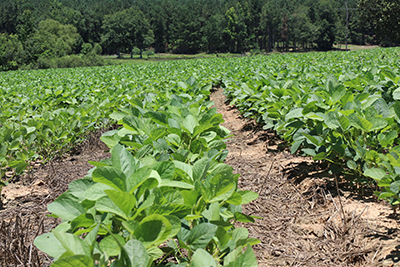Alabama Farmers Plant Less Cotton; More Corn, Soybeans, Peanuts And Wheat

By Debra Davis
COVID-19 indirectly impacted farmers’ decisions to plant less cotton this year, including farmers in Alabama.
World cotton demand was tracking at a slower pace before March, then the coronavirus sent markets tumbling. Lower cotton market prices encouraged farmers to seek more profitable options for this year’s planting, said the Alabama Farmers Federation’s Carla Hornady.
“Our cotton farmers rely heavily on export markets, and those markets declined when the pandemic hit,” said Hornady, the Federation’s Cotton, Soybean, and Wheat and Feed Grain divisions director. “At the same time, U.S. manufacturing slowed — or in some cases stopped completely for a while— diminishing the domestic demand for cotton. In March, the price for cotton dropped below 50-cents a pound as farmers were making final plans for planting spring crops. Farmers need at least 65-cents a pound for cotton to break even. Prices have rebounded some, but final planting decisions were already made.”
The U.S. Department of Agriculture (USDA) June acreage report was released June 30. It showed Alabama farmers planted 470,000 acres of cotton, 13% less than last year’s 540,000 acres.
Many of the acres planted in cotton for 2019 likely ended up in corn and soybeans this year, Hornady said. Alabama farmers planted 370,000 acres of corn, an increase of 16% over last year’s 320,000 acres. Soybean acreage jumped 17%, from 265,000 acres in 2019 to this year’s 310,000 acres.
Alabama peanut farmers also planted more acres for 2020, digging in for 170,000 acres; a 6% increase over the previous year’s 160,000.
While Alabama planting decisions mirrored national choices for cotton, corn, soybeans and peanuts, state farmers bucked a national trend showing U.S. farmers planted less wheat.
Planting reports show Alabama farmers planted 140,000 acres of wheat this year compared to 130,000 acres last year, translating to an 8% increase. Meanwhile, USDA reported 44.3 million acres of wheat were planted nationally, a 2% drop since last year. That represents the lowest wheat acreage in the U.S. since records began in 1919.
Hornady said global wheat production and world wheat stocks are at record levels, and prices are low.
“U.S. wheat is facing stiff competition from other global producers (namely Russia and Ukraine) that raise wheat with higher average protein levels than American varieties,” she said. “Wheat prices are low, and it’s hard for farmers to make it profitable.”
